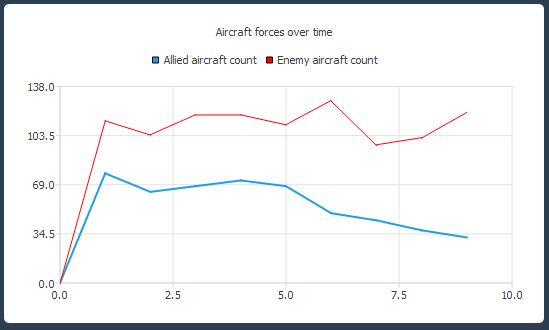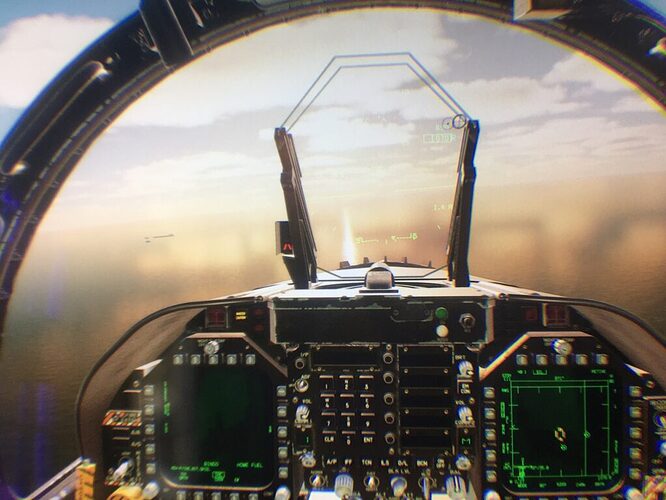# DCS: Liberation
By @BeachAV8R - NOVEMBER 16, 2019
Originally published at: Articles - Mudspike Forums
It has long been known that DCS World is a great sandbox – DCS Liberation turns that sandbox into a playground…!
For all of the wonderful things that DCS World has evolved into over the years, there remains the admittedly noisy elephant in the room that the core product lacks what is arguably the single most desired feature in a combat flight simulation – a dynamic campaign. According to Eagle Dynamics (ED), a dynamic campaign engine is in the works and the community is excited to know it is a high priority item. Not content to wait for what could be an extended period of time, a group of DCS enthusiasts, initially spearheaded by Vasyl “shdwp” Horbachenko, who passed the torch to C. Perreau “Khopa” and a larger group of coders, embarked on a project to use an external program to bring a dynamic campaign into DCS World. The result: DCS Liberation.

Liberation is self described by the authors as: “…a turn based single-player or co-op dynamic campaign. It is an external program that generates full and complex DCS missions and manages a persistent combat environment.”
So for those that are paying attention – some key words:
- single-player OR co-op
- dynamic campaign
- full and complex missions
- persistent combat environment
Right on. Let’s dig in! (Note: All in game images were taken through the lens of an HP Reverb – thus, they will appear slightly blurry.)
Liberation 2.5.1
The bulk of this article was researched, played, and tested using the latest stable release of Liberation version 2.5.1. A more cutting edge development version of Liberation is under constant improvement, with a version 3.0 on the very near horizon. Given what we experienced playing 2.5.1, we can only imagine that Liberation is getting better and better with each iteration.
Liberation installs to a stand-alone directory from which it runs while referencing your DCS savegame and main DCS installation directory. I am not a smart man, so it was described by our resident @fearlessfrog as a python program that talks to DCS via a mission file and a LUA script. Sure.
A start-up wizard takes you through the steps of creating a new campaign. Campaigns are available for all of the DCS World maps and they are diversified with different orders of battle, time periods, objectives, and campaign area sizes. It is anticipated that v3 will have similar campaigns, but they will likely need to be tweaked a bit to work with the v3 Liberation architecture which is slightly different.
With responsibility for the conduct of the war comes the need to finance the procurement of air and land assets. The acquisition and spending of money toward reinforcing and expanding your forces is paramount to the gameplay, but can be as easy or complicated as you wish to make it. Sliders allow you to determine the difficulty of the campaign based on how much cash each side can generate via a multiplier. Starting budgets can be set as well. Player assistance comes in the form of automating some functions such as runway repairs, front-line (ground) forces purchasing, and aircraft purchasing.
Once you have made your initial campaign structure settings, all that is left is to hit the FINISH button. An important thing to remember is that Turn 0 is your initial purchasing and setup phase and that gameplay won’t commence until Turn 1. For our multiplayer Mudspike test server we decided to run the fantastic Persian Gulf – Emirates campaign which focuses on U.S. forces retaking the northern UAE from Iranian forces. The scenario provides for a 4-slot airbase at Fujairah on the east coast, an aircraft carrier offshore along with an LHA. Front lines are marked with orange bars that will advance, retreat, or stay in place after each turn depending on how you and your forces have done. Routes toward each “node” show how the frontlines will advance – the goal is to capture nodes and economic facilities along the way. The more territory you capture, the more money you can earn and spend per turn.
With auto-populate on, you’ll find the CVN and LHA outfitted with some aircraft, the ground forces deployed, and for this specific campaign you are given a starting budget for Turn 0 of $2000M to further round out your forces. This is where some decision making comes into play. If you are planning to play a multiplayer game, make sure you purchase airframes that will allow you and your friends to fly the types of aircraft they prefer (if they are even included in the order of battle). Each airframe and ground asset costs money – Turn 0 is definitely one of the most important since it sets the base level of forces for your faction. Subsequent turns typically generate far less income, in some cases not even enough money to offset your losses. If you choose the auto-populate option, you may find yourself wanting to rebalance at some point by selling assets to provide the cash to invest in other air or ground forces.
- Pre-Turn planning.
- Evaluate financial resources
- Evaluate map for progress
- Check intel on enemy forces
- Decide whether to put our forces on aggressive, defensive, ambush, retreat, or breakthrough
- Buy units for the front line and/or units that defend our nodes
- Repair damaged infrastructure and or defensive anti-aircraft networks
- Evaluate airbases/CVN/LHA for aircraft available
- ATO
- Evaluate short term objective (maybe seizing a node)
- Evaluate economic damage we could incur by destroying enemy resource generators (factories, refineries, oil facilities, etc.,)
- Plan my flight package as part of the ATO (we were flying a 3-ship flight in Hornets for the duration of the campaign)
- Plan support flights for our specific flight (SEAD, DEAD, CAP, or SWEEP)
- Check auto-generated ATO to see if it fits our overall goals (add or delete flights as necessary)
- Hit TAKE-OFF!
Once you are satisfied with the ATO and have planned your overall objectives (we did this collectively as a group, which was half of the fun doing the strategy between the three of us) hitting the TAKE-OFF button generates a mission file (.miz). Since I was hosting the mission on a dedicated DCS server, my workflow had a couple extra steps:
- Hit TAKE-OFF!
- .miz file generated on the computer with Liberation installed (the server)
- Copy the .miz file to my desktop computer where DCS is installed (the computer I use to actually fly in DCS)
- Open the .miz file in the Mission Editor then immediately save it
- Copy the .miz file from the desktop computer back to the server computer
- Launch DCS Standalone server and load the .miz file to allow clients to join
In the twenty or so turns we flew to complete our Liberation campaign, I think we only suffered only three or four disconnects, that were likely due to my server bandwidth. The disconnects only disconnected one client and the others were free to continue the mission. In my mind, I looked at it as a mechanical issue with the aircraft as it were. Again, as long as the server is running the mission, the ATO is being conducted and the struggle between RED and BLUE continues regardless of whether you are cooking hot dogs when you are supposed to be flying, or out there becoming a single-mission ace. Since the Liberation executable file is running you also get a real time update on the units and infrastructerthat it is tracking as destroyed or damaged.
Once you want to terminate the turn, you can simply stop the mission on the server, Liberation detects that the mission has reached a conclusion, and the results and next turn are generated. We found this was an exciting time..a period of 15 or 20 minutes while I compiled the results and would post them up to the group to learn if we had made progress or failed miserably. I will say that the beginning of our campaign was pretty tough and I was starting to wonder if we would be able to recoup enough to push forward.
Liberation accounts for the damage and destruction of units (both RED and BLUE) and carries forward those statistics to the next turn. Therefore, if your side destroyed ten MiG-29s during the conduct of the ATO, the enemy will have ten less MiG-29s available for the next turn. This is another important consideration because after the mission is flown and you are looking at the results in Liberation, you are actually planning reinforcements that will not show up until TWO turns in the future.
For example, if my side lost four Hornets in the mission I just flew (say Turn 3), I can purchase four to replace them, but they won’t be available for the mission I’m planning at the moment, but for the mission AFTER that one (Turn 5). This seems like an excellent gameplay mechanic that forces you to think a bit down the road.
It is hard to overstate how immersive it is flying your mission when perhaps dozens of other flights are going about their missions. All manner of aircraft are in motion from E-2Cs, tankers, SWEEPS, CAS, STRIKE, SEAD, DEAD, BARCAP, CAP – you name it. Of course, Liberation is constrained by some of the quirky things that DCS AI does, but the overall experience is fabulous. (Pro tip – don’t put Harriers on the CVN!). We saw some glitches with things like F-14s getting stuck on the carrier catapults or Harriers dropping rockets instead of firing them, but these are internal DCS bugs that really have nothing to do with Liberation. You quickly learn the workarounds such as making some CVN based flights start airborne instead of cold-starts so that the AI doesn’t get stuck anywhere. Usually it works fine though, and seeing flight after flight taxiing to the catapult to launch off on their missions is awesome.
As the war unfolds turn-by-turn, you will witness your frontlines move on both the Liberation planning map and in game as the smoke and fire advances or retreats according to your fortunes. You can involve yourself as little or as much in the planning of the overall war by adding or deleting packages and directing the aggressiveness or passiveness of your ground troops. There are statistical risks to pushing too hard too soon. Yes, there are ways to “game the game” so to speak. We tried to play our whole campaign with an eye toward a realistic approach to our ground forces. As it stands now, apparently the main battle tanks are ridiculously overpowered and will plow through most defenses. I had occasion to see anti-tank missiles take out our Abrams, so the enemy does have ways to combat overwhelming force. In the spirit of the campaign though, I did not overload our forces with heavy armor and instead struck what I felt was a semi-realistic balance of heavy armor , artillery, recon, and support units.

Valuable intel can be gained on enemy forces, but keep in mind that the enemy may have reinforced on an earlier turn that will now show up on the turn you are getting ready to fly – so just because an SAM site enemy stronghold is weakened on your preflight Liberation map doesn’t mean that it won’t be alive if the enemy repaired it on the previous turn. (I have been informed that enemy SAM sites do not rebuild in v2.5.1.)
As the ground war rages on, nodes are taken or lost and you may find yourself able to open up new operations from seized airfields. As you gain ground, you also gain the resources that the enemy has left behind. Sometimes those factories or refineries are pounded to rubble, so it may take an investment to get them up and running again. Seizing infrastructure is the best way to build revenue on a per-turn basis. It would not be an illegitimate tactic to strike the enemy in the pocket book as well as outright destroying units.
It is also worth mentioning that Liberation has a very intuitive manual ATO building system that just requires a few clicks to select a type of mission, time on target (TOT), and package makeup. Once you have done those things, Liberation automatically sets waypoints and altitudes, as well as divert fields and waypoints where you may JOIN or ESCORT another flight. All of this data automatically appears on the kneeboard in game and it is extremely well presented.
Weather and visibility are considerations for the client flown missions within the ATO since low clouds, ceilings, or reduced visibility can influence the type of attacks you can fly and/or the effectiveness of targeting pods and other sensors.

The outcome of warfare is often determined by momentum and in our case, once we had moved south to capture the coastal node of Sohar we were in a position to start our push westward. Though funds were scarce during the first few turns of the campaign, each node also adds revenue per turn and we were able to keep our head above water. By the end of the campaign, after having assumed control of several nodes and nearby infrastructure facilities, we were reaching near $1000M per turn, which inexorably led to us being able to outspend the enemy on replacing destroyed units.


The closing turns of the campaign freed up enough funds for us to dabble with things like B-52 strikes and offensive counter air (OCA) strikes against enemy airfields. The most difficult portion of the campaign were the first six or eight turns when we faced a wily integrated air defense system (IADS) that managed to smack us down quite a few times.
VICTORY!
Conclusion
That is the quick and dirty on Liberation. Once v3.X releases we will take a look at some of the changes to the GUI and additional features that have been added and tweaked by the developers. They are extremely active on their Discord Channel and you can search there to your heart’s content for answers to any additional questions you may have.
I think Fridge summed it up best after we had flown the entire Emirates campaign and closed out our victory:
“You know the thing that I don’t like about Liberation? The feeling I get when I fly anything else in single-player – the feeling of a lack of a goal, or challenge, or of struggling to figure out how to implement a combat system.”
It is our intention here at Mudspike to open a Liberation server for our Mudspike members. We are still in the formative process of “the process” so keep an eye on the forums for announcements, polls, and questions. Given the global span of our membership, we will try our best to set up mission times that will allow everyone to join in the fun. The turn-based nature of Liberation also means we get to discuss strategies in the forums and formulate grand schemes on building each turn’s ATO.
We look forward to meeting and flying with all of you!
BeachAV8R, FearlessFrog, and Fridge























































